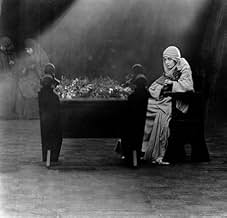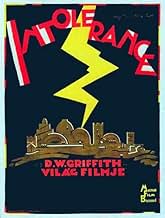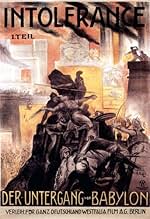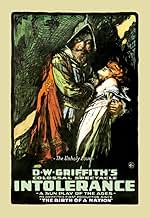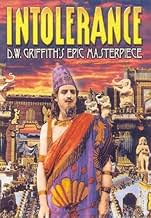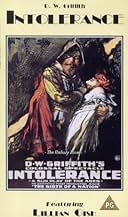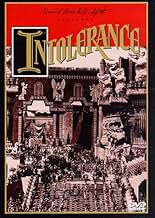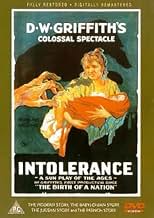IMDb रेटिंग
7.7/10
18 हज़ार
आपकी रेटिंग
एक गरीब युवती की कहानी, जो उसके पति और बच्चे से पूर्वाग्रह से अलग है, पूरे इतिहास से असहिष्णुता की कहानियों के साथ जुड़ी हुई है.एक गरीब युवती की कहानी, जो उसके पति और बच्चे से पूर्वाग्रह से अलग है, पूरे इतिहास से असहिष्णुता की कहानियों के साथ जुड़ी हुई है.एक गरीब युवती की कहानी, जो उसके पति और बच्चे से पूर्वाग्रह से अलग है, पूरे इतिहास से असहिष्णुता की कहानियों के साथ जुड़ी हुई है.
- पुरस्कार
- कुल 2 जीत
F.A. Turner
- The Dear One's Father
- (as Fred Turner)
Julia Mackley
- Uplifter
- (as Mrs. Arthur Mackley)
John P. McCarthy
- Prison Guard
- (as J.P. McCarthy)
फ़ीचर्ड समीक्षाएं
This silent film by director D.W. Griffith is well known to serious movie buffs and historians, but not to today's general public. I doubt that a lot of people these days would have the patience to sit through a film that contained three hours of silence. Nevertheless, the film's technical innovations inspired filmmakers in the 1920's and later, particularly in Russia and Japan. It also inspired filmmakers in the U.S., including Cecil B. DeMille and King Vidor. For this reason, and for other reasons, "Intolerance" is an important film.
The film's four interwoven stories, set in four different historical eras, are tied together thematically by the subject of "intolerance", a word which could be accurately interpreted today as "oppression", "injustice", "hate", "violence", and mankind's general inhumanity.
Griffith's narrative structure, though innovative, is uneven, because he gives more screen time to two of the four stories (the "modern" and the "Babylonian"). Equal time for three stories, thus deleting the fourth, might have worked better.
To me, the Babylonian story is the most interesting one because of its more complete coverage, and because of its elaborate costumes and spectacular sets. Even though there is no script, the viewer can easily discern the plot, which suggests that some of today's films might be just as effective, or more so, if screenwriters would downsize the dialogue.
What "Intolerance" offers most of all to contemporary viewers is a sense of perspective. Someone once said that despite the enormous advances in technology, society itself has advanced not at all. That may be true. In the eighty plus years since the film was released, technical advances in film-making have been obvious and impressive. But we are still plagued with the same old human demons of oppression, injustice, hate, violence, and ... intolerance.
The film's four interwoven stories, set in four different historical eras, are tied together thematically by the subject of "intolerance", a word which could be accurately interpreted today as "oppression", "injustice", "hate", "violence", and mankind's general inhumanity.
Griffith's narrative structure, though innovative, is uneven, because he gives more screen time to two of the four stories (the "modern" and the "Babylonian"). Equal time for three stories, thus deleting the fourth, might have worked better.
To me, the Babylonian story is the most interesting one because of its more complete coverage, and because of its elaborate costumes and spectacular sets. Even though there is no script, the viewer can easily discern the plot, which suggests that some of today's films might be just as effective, or more so, if screenwriters would downsize the dialogue.
What "Intolerance" offers most of all to contemporary viewers is a sense of perspective. Someone once said that despite the enormous advances in technology, society itself has advanced not at all. That may be true. In the eighty plus years since the film was released, technical advances in film-making have been obvious and impressive. But we are still plagued with the same old human demons of oppression, injustice, hate, violence, and ... intolerance.
This mammoth production and DW Griffith's 1916 masterpiece was his followup to The Birth of a Nation. Intolerance blends 4 stories of historical intolerance as a warning against the current-day evils of war. The French and Judean stories are OK. The Babylonian and Modern stories are spectacular. Where Griffith experimented with closeups and intercutting stories in Birth of a Nation, these techniques are mastered in Intolerance. Griffith also continues his incredible eye for composition and scenery and costumes in this epic film.
The sets and costumes for the Babylonian story are among the best in film history. And the battle scenes equal anything in Birth of a Nation. Griffith's Babylonian set is so huge it allows for horse-drawn chariots to ride side by side on the road at the top of the towering walls. The camera shot that shows the chariots and the battle many stories below is astounding. There is also the famous camera shot that slowly moves closer and closer the the city steps and gates where hundreds of dancers perform a pagan production number. Just amazing.
The emotional oomph of this film comes from the modern story where a young couple living in a tenement apartment almost gets destroyed by society do-gooders. The intercutting of scenes here is masterful as the rescuers race to save the hero who is about to be hanged. Melodrama to be sure, but in a form never seen before 1916.
And as usual Griffith assembles a terrific cast and elicits great performances from many of them.
Constance Talmadge plays the cinema's first feminist heroine as the Mountain Girl in the Babylonian story. She's wonderful as the saucy girl who eats onions while on the block to be sold as a slave. As the men come near to examine her (she's dressed in a pelt) she shakes her onions at them and kicks at them. Hilarious. The story is complicated but she overhears a plot to attack the city and the ruler (who set her free) she adores. Great scenes of Talmadge racing a chariot through the desert. Great battle scenes that are unforgettable. Great orgy scenes. This is just a wonderful story that is so eye-filling, you have to watch it several times to take everything in.
The modern story boasts a perfect performance by Mae Marsh as the "Dear One." Robert Harron is the husband, and Miriam Cooper (very underrated) is the "bad girl." One of the most harrowing scenes I can remember is when the "do-gooders" (headed by Vera Lewis) come to take Marsh's baby after Harron is falsely arrest for murder. Marsh is so realistic in this frenzied scene that your heart just stops. Harron is also excellent as the hapless boy who gets framed for murder. The editing of this arc of the film sets the standard for decades to come.
Intolerance must be seen by any serious film buff. It's a long film but is unforgettable. The cast list is impressive and includes the above-mentioned Constance Talmadge, Mae Marsh, Robert Harron, Miriam Cooper, Lillian Gish, Vera Lewis, Ralph Lewis, Douglas Fairbanks, Bessie Love, Wallace Reid, Elmo Lincoln, Elmer Clifton, Mary Alden, Constance Collier, Carmel Myers, Erich von Stroheim, Donald Crisp, Carol Dempster, Marguerite Marsh, Tully Marshall, Natalie Talmadge, Alma Rubens, Seena Owen, Margery Wilson, Eugene Palette, Ethel Grey Terry, Owen Moore, Alfred Paget, Joseph Henabery, Josephine Crowell, Ruth St. Denis, Ted Shawn, Mildred Harris, Walter Long, Sam De Grasse, Monte Blue, Kate Bruce, Nigel De Brulier, Pauline Starke, Lillian Langdon, and future directors King Vidor, Frank Borzage, and Tod Browning!
The sets and costumes for the Babylonian story are among the best in film history. And the battle scenes equal anything in Birth of a Nation. Griffith's Babylonian set is so huge it allows for horse-drawn chariots to ride side by side on the road at the top of the towering walls. The camera shot that shows the chariots and the battle many stories below is astounding. There is also the famous camera shot that slowly moves closer and closer the the city steps and gates where hundreds of dancers perform a pagan production number. Just amazing.
The emotional oomph of this film comes from the modern story where a young couple living in a tenement apartment almost gets destroyed by society do-gooders. The intercutting of scenes here is masterful as the rescuers race to save the hero who is about to be hanged. Melodrama to be sure, but in a form never seen before 1916.
And as usual Griffith assembles a terrific cast and elicits great performances from many of them.
Constance Talmadge plays the cinema's first feminist heroine as the Mountain Girl in the Babylonian story. She's wonderful as the saucy girl who eats onions while on the block to be sold as a slave. As the men come near to examine her (she's dressed in a pelt) she shakes her onions at them and kicks at them. Hilarious. The story is complicated but she overhears a plot to attack the city and the ruler (who set her free) she adores. Great scenes of Talmadge racing a chariot through the desert. Great battle scenes that are unforgettable. Great orgy scenes. This is just a wonderful story that is so eye-filling, you have to watch it several times to take everything in.
The modern story boasts a perfect performance by Mae Marsh as the "Dear One." Robert Harron is the husband, and Miriam Cooper (very underrated) is the "bad girl." One of the most harrowing scenes I can remember is when the "do-gooders" (headed by Vera Lewis) come to take Marsh's baby after Harron is falsely arrest for murder. Marsh is so realistic in this frenzied scene that your heart just stops. Harron is also excellent as the hapless boy who gets framed for murder. The editing of this arc of the film sets the standard for decades to come.
Intolerance must be seen by any serious film buff. It's a long film but is unforgettable. The cast list is impressive and includes the above-mentioned Constance Talmadge, Mae Marsh, Robert Harron, Miriam Cooper, Lillian Gish, Vera Lewis, Ralph Lewis, Douglas Fairbanks, Bessie Love, Wallace Reid, Elmo Lincoln, Elmer Clifton, Mary Alden, Constance Collier, Carmel Myers, Erich von Stroheim, Donald Crisp, Carol Dempster, Marguerite Marsh, Tully Marshall, Natalie Talmadge, Alma Rubens, Seena Owen, Margery Wilson, Eugene Palette, Ethel Grey Terry, Owen Moore, Alfred Paget, Joseph Henabery, Josephine Crowell, Ruth St. Denis, Ted Shawn, Mildred Harris, Walter Long, Sam De Grasse, Monte Blue, Kate Bruce, Nigel De Brulier, Pauline Starke, Lillian Langdon, and future directors King Vidor, Frank Borzage, and Tod Browning!
Everything about this movie is fascinating, even its numerous flaws. It is as ambitious a movie as has ever been made, and if you adjust for the era, it might also be the most lavish, expensive, and painstaking. Even today the scope and detail stand out, despite the many technical limitations in its era. Likewise, the enormous cast list contains many names that silent film fans will recognize at once, with well-known performers even in some of the minor roles. Then, you could write many pages about the stories, which are filled with weaknesses, but which are also so interesting that you never want to miss what will happen next.
The concept behind "Intolerance" is as enterprising as it gets: no fewer than four complete, independent story-lines, with the movie switching back-and-forth among them, not necessarily in consecutive order but with a definite plan in mind, all in order to get across the idea suggested by the title - that is, that intolerance of others' beliefs or lifestyles has been a destructive force throughout history. It is generally understood that there is a strong dose of defensiveness behind this plan, since the ideas promoted in Griffith's previous film had earned for him some severe and well-justified criticism. This personal motivation could well explain why "Intolerance" is often so overblown, and it also is interesting in light of the stories chosen to illustrate the main themes.
The two most straightforward stories - the persecution of the Huguenots in 16th century France, and the persecution of Jesus Christ by the religious leaders of his day - are also the most believable, and yet they do not seem to get quite the screen time or the lavish detail of the other two. The contemporary story may have been the most important to Griffith, and it is a full-scale melodrama, full of heavy-handed developments and very unlikely coincidences, yet certainly a story that will hold your attention. The Babylonian story is at once the strangest choice, the most extravagant, and the most fascinating of all. As history, it is as distorted as (or more so than) any of today's movies. Trying to pass off Belshazzar of Babylon as a model of justice and tolerance is just weird, and the entire historical scenario is at best an imaginative embellishment of the truth. But the involved story that Griffith tells in this setting is so exciting and entertaining that you just can't take your eyes away from it.
Much, much more could be said, but anyone with an interest in silent movies or in cinema history will want to watch it and draw his or her own conclusions. Whether you want to analyze the vast array of themes, events, and ideas, or whether you just want to sit back and enjoy a fascinating spectacle, the three hours fly by very quickly, and it's a movie you won't forget.
The concept behind "Intolerance" is as enterprising as it gets: no fewer than four complete, independent story-lines, with the movie switching back-and-forth among them, not necessarily in consecutive order but with a definite plan in mind, all in order to get across the idea suggested by the title - that is, that intolerance of others' beliefs or lifestyles has been a destructive force throughout history. It is generally understood that there is a strong dose of defensiveness behind this plan, since the ideas promoted in Griffith's previous film had earned for him some severe and well-justified criticism. This personal motivation could well explain why "Intolerance" is often so overblown, and it also is interesting in light of the stories chosen to illustrate the main themes.
The two most straightforward stories - the persecution of the Huguenots in 16th century France, and the persecution of Jesus Christ by the religious leaders of his day - are also the most believable, and yet they do not seem to get quite the screen time or the lavish detail of the other two. The contemporary story may have been the most important to Griffith, and it is a full-scale melodrama, full of heavy-handed developments and very unlikely coincidences, yet certainly a story that will hold your attention. The Babylonian story is at once the strangest choice, the most extravagant, and the most fascinating of all. As history, it is as distorted as (or more so than) any of today's movies. Trying to pass off Belshazzar of Babylon as a model of justice and tolerance is just weird, and the entire historical scenario is at best an imaginative embellishment of the truth. But the involved story that Griffith tells in this setting is so exciting and entertaining that you just can't take your eyes away from it.
Much, much more could be said, but anyone with an interest in silent movies or in cinema history will want to watch it and draw his or her own conclusions. Whether you want to analyze the vast array of themes, events, and ideas, or whether you just want to sit back and enjoy a fascinating spectacle, the three hours fly by very quickly, and it's a movie you won't forget.
Four storylines are followed. The first is set in the modern world, where The Dear One (Mae Marsh) and her beloved The Boy (Bobby Harron) are struggling to survive. He loses his job due to union striking after a pay cut mandated so that the company boss can fund his sister's charity work. That same charity takes away the Dear One's child, citing neglect, as the Boy is sent to jail after resorting to crime.
The Biblical "Judean" story recounts how intolerance led to the crucifixion of Jesus. This sequence is the shortest of the four.
The third story details the events of the St. Bartholomew's Day Massacre of 1572 where Huguenot protestants were killed under orders of the Catholic royalty.
The fourth story is set in ancient Babylon, and deals with a religious struggle between different sects that leads to their conquest by the Persians.
Griffith's masterpiece is a marvel of narrative and structural complexity for the time, and the Babylon scenes are truly awe-inspiring in their scope and ambition. The story, in which instances of "intolerance" are illustrated throughout the ages, is a bit muddled and more than a little pretentious, but the visualization is second-to-none.
It's been put forth that Griffith made this as a sort of apologia for the racial insensitivity of his previous mega-hit The Birth of a Nation, but Griffith scholars disagree, and say that Griffith was never ashamed by the racist nature of his last movie, and that the intolerance that he was speaking out against was that which had been directed at him over that film (shades of our current political climate).
Regardless, this ended up being the most expensive film ever made up to that point, and was a major flop at the box office, from which Griffith never really recovered. The film now stands as a colossal achievement, and a precursor to historical epics to come. There are various versions in circulation.
The Biblical "Judean" story recounts how intolerance led to the crucifixion of Jesus. This sequence is the shortest of the four.
The third story details the events of the St. Bartholomew's Day Massacre of 1572 where Huguenot protestants were killed under orders of the Catholic royalty.
The fourth story is set in ancient Babylon, and deals with a religious struggle between different sects that leads to their conquest by the Persians.
Griffith's masterpiece is a marvel of narrative and structural complexity for the time, and the Babylon scenes are truly awe-inspiring in their scope and ambition. The story, in which instances of "intolerance" are illustrated throughout the ages, is a bit muddled and more than a little pretentious, but the visualization is second-to-none.
It's been put forth that Griffith made this as a sort of apologia for the racial insensitivity of his previous mega-hit The Birth of a Nation, but Griffith scholars disagree, and say that Griffith was never ashamed by the racist nature of his last movie, and that the intolerance that he was speaking out against was that which had been directed at him over that film (shades of our current political climate).
Regardless, this ended up being the most expensive film ever made up to that point, and was a major flop at the box office, from which Griffith never really recovered. The film now stands as a colossal achievement, and a precursor to historical epics to come. There are various versions in circulation.
How on Earth was D.W Griffith able to make this movie back in 1916? Back in the days when the audience were having a hard time focusing on two parallell stories, Griffith gave them four... This is a tremendous spectacle, way ahead of its time, and hardly dated at all. OK, the acting is a little bit over the edge (although Mae Marsh is a personal favourite of mine) and the subtitles are sometimes ridiculous, but the message that this movie brings is absolutely timeless. In fact, this is really the first movie with a vision, an idea. A major influence on Russian director Eisenstein, one has to wonder: Would there have been a Potemkin without this masterpiece? The Birth of a nation is in some ways superior to Intolerance, but for pure strength, innovation and boldness, Intolerance is unsurpassed and unsurpassable. The greatest movie of all times.
क्या आपको पता है
- ट्रिवियाDuring filming of the battle sequences, many of the extras got so into their characters that they caused real injury to one another. At the end of one shooting day, a total of 60 injuries were treated at the production's hospital tent.
- गूफ़One of the early title cards in the Judean sequence refers to Jesus having been from "the carpenter shop in Bethlehem". Though he was born in Bethlehem, he worked with his father in a carpenter shop in Nazareth, which is why he was known as Jesus of Nazareth.
- भाव
Intertitle: When women cease to attract men, they often turn to reform as a second option.
- क्रेज़ी क्रेडिटConstance Talmadge is credited as 'Georgia Pearce' for her performance as Marguerite de Valois in the French Story. She is credited under her own name in the role of The Mountain Girl in the Babylonian Story.
- इसके अलावा अन्य वर्जनThe movie was officially restored in 1989 by Kevin Brownlow and David Gill for Thames Television. It was transferred from the best available 35mm materials, color-tinted per D.W. Griffith's intent, and contains a digitally recorded orchestral score by Carl Davis. This 176-minute version was released on video worldwide, but has never been telecast in the U.S.
- कनेक्शनEdited into The Fall of Babylon (1919)
टॉप पसंद
रेटिंग देने के लिए साइन-इन करें और वैयक्तिकृत सुझावों के लिए वॉचलिस्ट करें
- How long is Intolerance?Alexa द्वारा संचालित
विवरण
बॉक्स ऑफ़िस
- बजट
- $3,85,907(अनुमानित)
- चलने की अवधि
- 2 घं 43 मि(163 min)
- ध्वनि मिश्रण
- पक्ष अनुपात
- 1.33 : 1
इस पेज में योगदान दें
किसी बदलाव का सुझाव दें या अनुपलब्ध कॉन्टेंट जोड़ें


